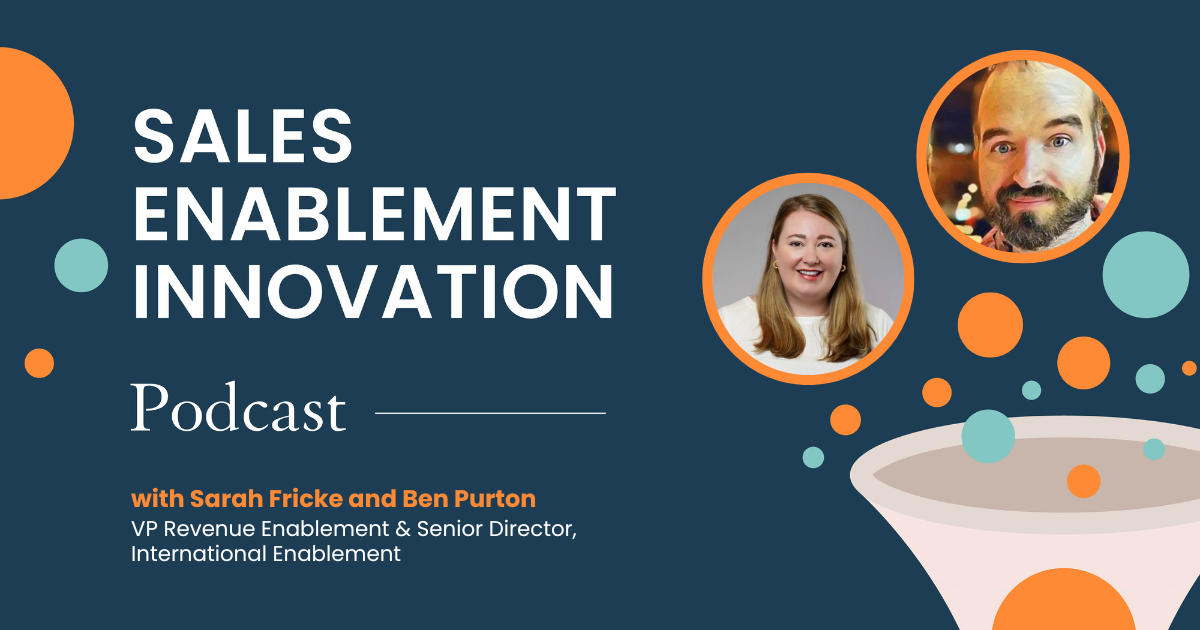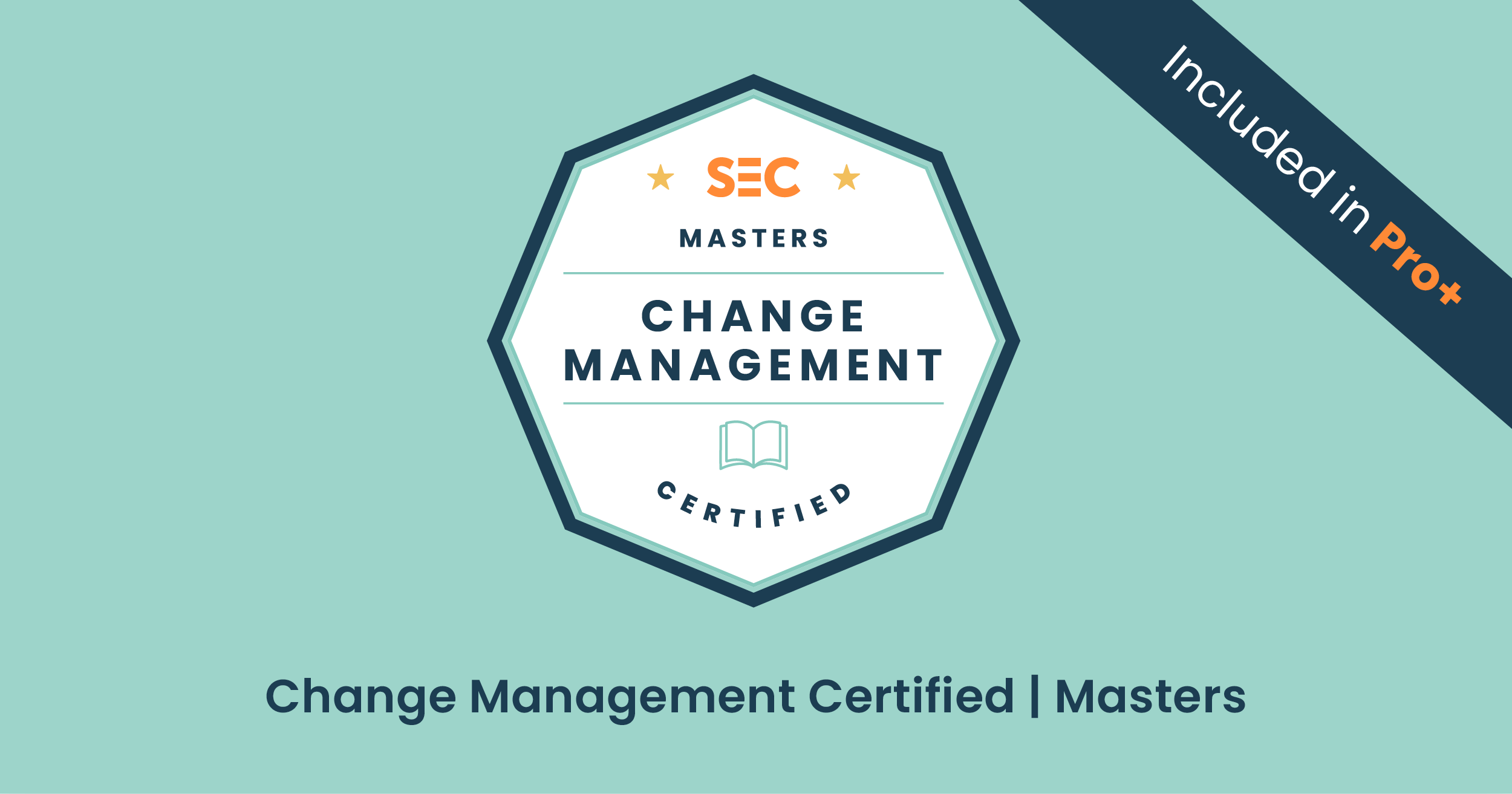Sales enablement teams are responsible for many changes within their organizations.
Whether it’s new sales methodologies, revamped onboarding processes, new ways of training and coaching sales reps, or something else entirely - change is at the heart of sales enablement’s role.
But what exactly is change management, and how can you use it in enablement?
In this article, we’ll dive into:
- The definition of change management
- Why using change management in sales enablement is important
- Risks to not using change management
- How you can learn to use change management techniques
Let’s get started. 👇
What is change management?
Change management is a strategic approach taken within an organization to move from its current state to a future desired state.
This is a coordinated effort to ensure that the change to systems and processes goes smoothly.
These projects typically aim to deliver business value to the organization, and aim to result in improved revenue growth in some way.
A good change management strategy will ensure that the change not only goes smoothly but also leads to the embedding of the change in the organization’s workflow.
Change management is about influencing culture as much as it is about influencing our ability to retain go-to-market employees. Because at the end of the day, change is about people and human behavior, so we can't just say: “Do this, do that”, and expect that everyone does it.
Del Nakhi, CEO & Founder of Lead to Catalyze at the Sales Enablement Summit San Francisco 2022
Why use change management in sales enablement?
Sales enablement professionals are agents of change by their very nature, and so it’s vitally important to understand how to use change management principles and techniques to make meaningful changes within an organization.
Almost every project an enablement team undertakes involves changing how people in the company operate.
Whether it’s a new onboarding program that requires more hands-on involvement from frontline sales managers, or the implementation of a new sales methodology or tool that changes how every sales rep goes about their day-to-day, sales enablement is about change.
Considering that 70% of business initiatives fail, either because there’s no change management framework in place or because the framework is implemented ineffectively, we can begin to understand that effective change management goes hand-in-hand with sales enablement success.
How can your enablement programs succeed if no one who’ll be affected by the changes understands how and why they’re happening?
If you’re a sales enabler, you’ve likely worked hard alongside relevant stakeholders in a project, performing informal change management without even realizing it! That’s how integral change management is to enablement.
The next step is to formalize your knowledge and understanding of the topic so that you can implement tried-and-tested change management techniques as part of the rollout of your next enablement initiative.
Risks to not using change management
Before diving into how you can apply change management techniques within your sales enablement team, let’s examine the risks of not using change management when rolling out new initiatives.
Unplanned downtime
A poor change management strategy can lead to problems during changeovers, which can result in unplanned downtime as the sales team can’t access critical tools or information.
For example, changing your CRM in a way that makes it unavailable to the sales reps stops them from effectively closing deals - ultimately resulting in lost revenue.
To avoid this outcome, ensuring the changes work as intended and teams understand how to use the new program is crucial.
Misaligned GTM teams
Misalignment within your GTM team can occur when you manage change poorly. Your stakeholders need to all be on the same page in order to succeed, otherwise, you risk misunderstandings, poor data tracking, and teams working in counterproductive ways.
To avoid this, ensure that you communicate what the change is, how it will affect stakeholders, and when it will take place in plenty of time, so everyone feels prepared.
Human error
Without a change management strategy, you might make mistakes as you implement changes to processes. And while this might be fine in a sandbox, if you skip straight to production this could cause some major issues, including:
- Confusion and misunderstanding among teams
- Badly implemented change
- Inaccurate data and reporting
I would go so far as to say if you don't have change management built into your enablement strategy, that your strategy is actually incomplete.
Del Nakhi, CEO & Founder of Lead to Catalyze at the Sales Enablement Summit San Francisco 2022
How to use change management in sales enablement?
Now that we’ve established why a lack of change management is harmful to your project’s prospects, it’s time to look at how you can implement change management best practices into your enablement workflows.
SEC’s Change Management: Certified course, led by experts Del Nakhi and Arup Chakravarti, goes in-depth into two major change management frameworks and how to implement them, allowing you to lead projects with confidence.
Before you jump into that packed curriculum though, here’s some general change management advice that you can use when building your next sales enablement project:
Define benefits
The first step of any successful change management strategy is to define and communicate the benefits of the change to stakeholders.
If the teams impacted don’t understand the reason for the change they are more likely to fail to adopt the change into their workflow. In turn, causing your change process to fail.
Clearly explaining the benefits of the change in a tangible way such as time saved or money lost will incentivize the stakeholders to care about the change and implement it.
You should also communicate what challenges the change may bring to the team, as this will build trust and allow you to gain feedback on potential deal breakers before the change takes place.
Buy-in from management
Managers are great allies when implementing a change. They can help to direct their team towards making the most of the new system.
Without management buy-in, adoption rates may be lower as the team’s manager doesn’t care about the change, so the team feels like they can get away with using any system they like.
If you can’t get the team’s managers to buy in it might be time to go up an organizational level to upper management to help push the change. As long as you have a strong benefit statement, this shouldn’t be too tricky.
Test, test, test
Testing is a crucial part of change management. If the change breaks the system or is complicated to use, adoption rates will be low and you risk having unplanned downtime.
Think outside of the box and try to break the system in any way you can think of. Then ask your team to do the same. If you can’t break it then it’ll hold up when launched.
However, if it breaks make sure to work out how and why it broke and fix it before launch. But don’t stop testing there, ask some future users of the system (e.g. sales reps) to try out the system.
Give your sales reps minimal instructions, to see how intuitive your new process is. The areas they get stuck in should be improved so that users are less likely to get frustrated and return to an outdated system.
Recruit champions
Recruit individuals to champion your change and spread the word of its benefits across their team. This is especially useful if you can turn around a vocal skeptic.
If someone is negative about the project publicly, ask them to show them the benefits of the changes and explain how it’ll work. If you can convince them the project is important they’re likely to spread the word.
People talk, so use this social proof to your advantage to increase stakeholder adoption.
Early preview
As a bonus for your champions, let them preview the project early. Their feedback will be useful in refining the changes and catching problems before the mass rollout.
Plus, your champions will feel involved in the project and will want it to succeed, making them even more valuable as champions.
Communicate the details
Typically people hate change - so make sure to communicate with stakeholders at each stage of the project to help them prepare for the changes.
Here’s a list of things affected teams should know:
- Benefits of the project
- How the change will affect them
- When will the project launch
- What support and resources are available
- Who to contact if there’s a problem
Define, measure, and evolve
Before launching, define what metrics you’ll be tracking and some goals for the project. This will help you to truly see the impact the changes have made.
Measure these metrics frequently - it may take some time for the changes to show!If the project isn’t as successful as planned, go back and make some adjustments.
Change management is that it’s an iterative process, not a static event. So continue to evolve and iterate the project.
When you have established with your company that you have this change management approach, you can go back and say: “OK, we're going to start with this - this is the first step in the process".
Del Nakhi, CEO & Founder of Lead to Catalyze at the Sales Enablement Summit San Francisco 2022
Become Change Management Certified
Overall having an effective change management strategy is crucial for a smooth transition toward a more efficient process or project.
In SEC’s Change Management: Certified course Founder and CEO of Lead to Catalyze, Del Nakhi, and Director of Sales Excellence at Equifax UK, Arup Chakravarti use their combined 35+ years of experience to teach you how to:
- Prepare to lead and facilitate strategic change
- Learn to implement a change framework for your own organization
- Overcome common change management challenges
With their guidance, you can become an expert in facilitating organizational change through coaching and the use of change management frameworks and models.


Sales enablement insider
Thank you for subscribing
Level up your sales enablement career & network with sales enablement experts
An email has been successfully sent to confirm your subscription.
 Follow us on LinkedIn
Follow us on LinkedIn












